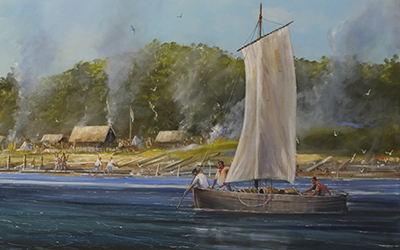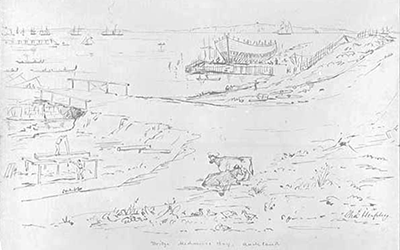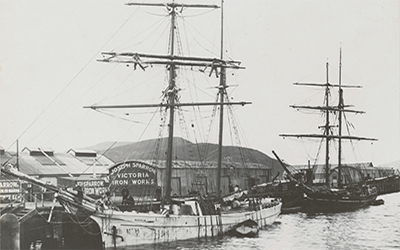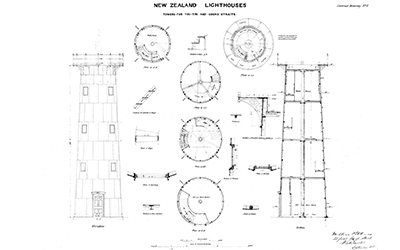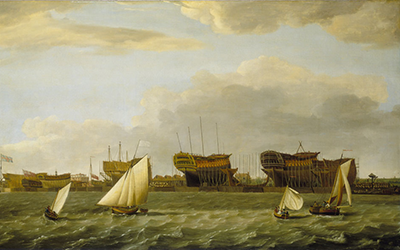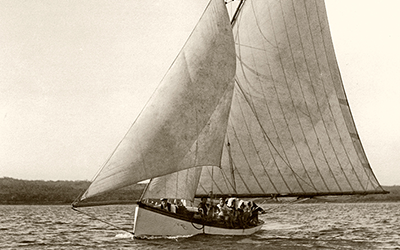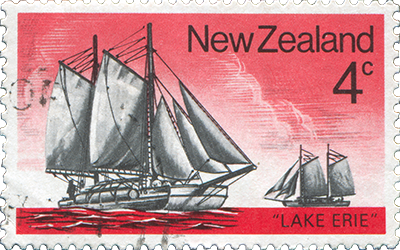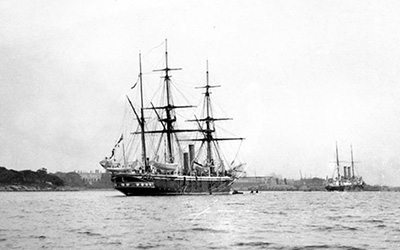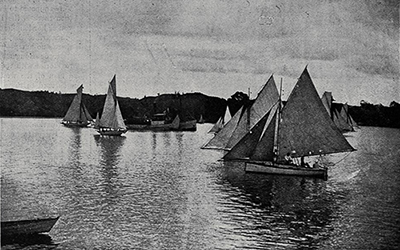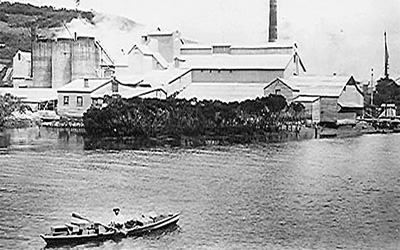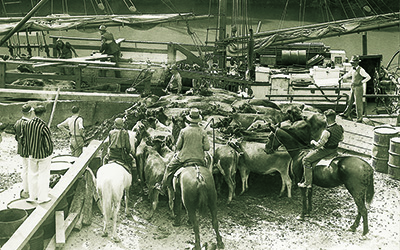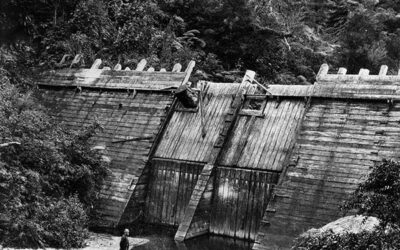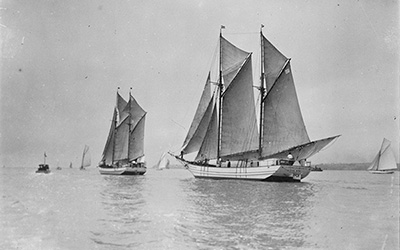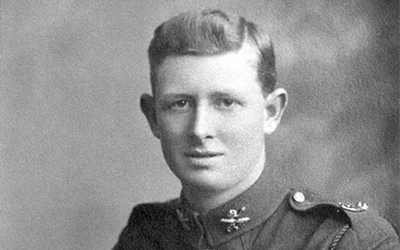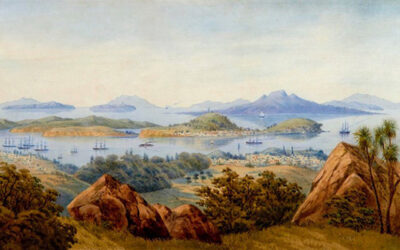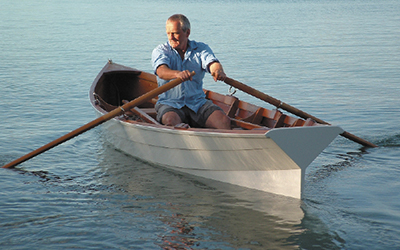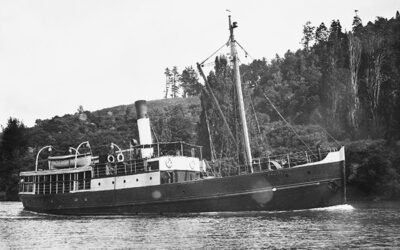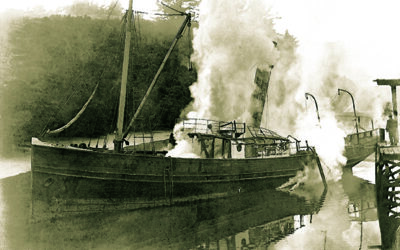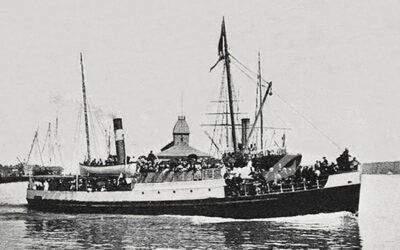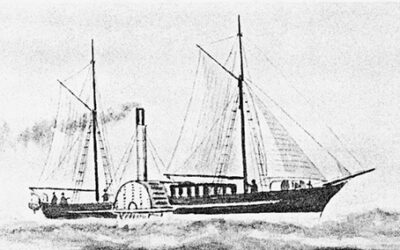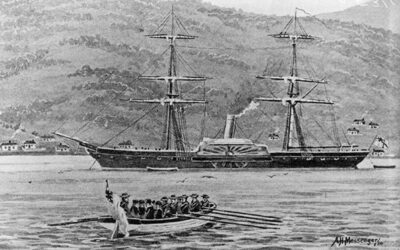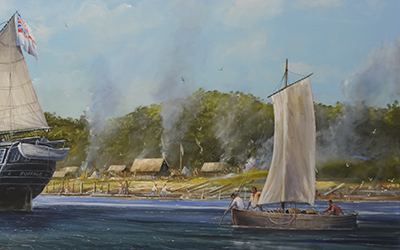Jade River: A History of the Mahurangi
Ronald H LockerFirst published 2001. Published online 2014–. This online edition is a work in progress…
Part 5 A maritime community
Vessels built beside the Mahurangi by year by builder
Following are listed vessels known to have been built in Mahurangi Harbour from circa 1832 to 1880, by Pākehā builders many of whose stories are told in Part 5 – A Maritime Community. Sadly, neither the name of the boat built at Spar Station Cove, nor its builder there, is known…
Scow-building Darrochs of the Clyde
George Darroch, born 1797, was one of six children born to James and Elizabeth née Murray, in Whitehouse. This village lies on the southern shore of Loch Tarbet, the sea-loch that is the northern limit to Kintyre. James’ line went back five generations to Mulmuroch…
Darrach and sons of Prince Edward Island
Prince Edward Island, the smallest province of Canada, is possibly best known as the site of the novel Anne of Green Gables. It lies within the Gulf of Saint Lawrence, off Nova Scotia, of which it is not part. It was from the adjacent Cape Breton Island, part of Nova Scotia…
Darrachs and Darrochs of Colonsay and Kintyre
The next two shipbuilding families on the Mahurangi Harbour, and the most notable, shared a common ancestry. The names Darroch and Darrach are but variant spellings of the same name. They represent a clan in Argyll of Clan McDonald of the Isles. The family…
Thomas Scott lands in the Mahurangi
Thomas Scott, builder of the William, the third vessel of 1849, was no transient. His efforts marked the beginning of a Mahurangi Harbour industry. Thomas Stuart Scott was born around 1800 at Blackwall, and grew up among the sights and sounds of shipbuilding. It seems…
Great lesser boatbuilders of the Mahurangi
A number of other boatbuilders worked briefly on the Mahurangi or nearby. Builders at Mangawhai, Pākiri, Ōmaha, Ōrewa and the Wade are not included here. The appendix lists those who built at Waiwera, Pūhoi, Mahurangi and Matakana, that is at Mahurangi in…
Boatbuilding begins in the Mahurangi
Some of the first vessels to be built in the Mahurangi may well have gone unrecorded, since registration was a little haphazard in those times. But it is clear that the first shipwrights established themselves after the Mahurangi Purchase of 1841 and…
Canadian Maritimers to New Zealanders
Sheltered coves and good timber were prerequisites for shipbuilding. These the Mahurangi coast had in abundance, but the third ingredient was shipwrights. Outstanding among the pioneers of the industry here were the Scottish immigrants from the Maritimes…
Art of the chartmakers Cudlip Pudsey-Dawson et al
During his voyages of 1833, Henry Williams records scrambling to the south end of Kawau “to take bearings of the various islands points etc. around us…” and climbing Motutapu to take similar bearings around the Waitematā. We are reminded that the charts we…
Cutter calm before the storming scow
Although Mahurangi settlers were not far from Auckland, the journey overland was arduous and to be avoided. By water, it is only 26 nautical miles to the Waitematā, via the semi-sheltered waters of the Hauraki Gulf. From the 1850s till the 1930s, sail was the settlers’…
Extraordinary Mahurangi rowers
Importance of good rowing boats to the settlers is emphasised in the previous chapter. A number of rowing stories survive which deserve inclusion here. In these days when most boatmen appear to need an outboard to get from the beach to their…
As mate of the Jane Gifford
When I was on Jane Gifford with my brother Reg, we would leave Warkworth if the tide was favourable at 3.30 am. Reg would go down to the Collins’ home by the Masonic Hall, bang on the door to waken me, then return to the boat and heat up…
Kauri logger to back aboard
Tudor’s apprenticeship on the Kasper scows came to an end during the First World War. He went into camp at Trentham and had sailed for the front when the troopship was turned around by the armistice. Tudor went back to the family home in…
Life aboard the Kasper scows
I left school at 14, having passed standard sixthe ‘proficiency exam’, then the culmination of schooling at year eight, and went to work for Warnock Brothers, the big soap people at Grey Lynn, wrapping up sandsoap. I stuck it out for about four months and then joined my brother Jim at Donald Brothers fellmongery. This meant…
Memoirs of a scowman
New Zealand’s scows are a colourful part of the history of the Auckland Province, and have an enduring fascination for latter-day sailors. The hardy scowmen were seldom given to literary expression, and most of their stories died with them. We must be grateful to the few…
Early end to 1800s Mahurangi boatbuilding
This substantial boatbuilding activity at Mahurangi declined in the late seventies and died in 1880. The reasons do not appear to be local. It was not due to lack of human or material resources. The original major builders had died or grown old, but…
Mahurangi elegant punt
On the Mahurangi, getting to work, to school, or to social events; meeting the steamboats, cream launches or neighbours; or bringing home necessities such as firewood, usually meant rowing, often for miles at a time. Some of the more epic rowing stories are told in the next chapter. For the shoreline families, a good…
Lifeline of the north
The Northern Steamship Company was the brainchild of Captain Alexander McGregor, another shipwright, mariner and entrepreneur of the Nova Scotian breed, who had come to New Zealand by way of Australia. In 1847 he built a small schooner, the Random, in the bay that bears his name. He then…
Deadly steamboat rivals
The Rose Casey was bought late in 1888 by Alexander McGregor, who had just left the management of the Northern Steamship Company (which he had founded in 1881; see later). He kept her on her well-established runs, advertising at New Year 1889 improved services and weekend…
Casey’s empire
After these three abortive starts, the honour of establishing the first lasting steam service to the Mahurangi fell to the paddle steamer Lady Bowen. Her owner was the Irish entrepreneur, Jeremiah Casey, born in Cork in 1820, son of a farmer. Around 1845 he married…
Steam comes to the Mahurangi
Henry Pulham in 1889 recalled the beginnings of steamboat service to the Mahurangi. He said the cutter Francis was the only means of getting to town, although for some weeks in 1855 the steamer Wonga Wonga ran here. Some settlers were persuaded…
Steam comes to the Waitematā
In the wider world, the great age of steam was well under way, a product of the inventive spirit of British engineering. As railways crisscrossed Britain in the 1830s, the first steamships were being built, and were destined to have a profound impact on global navigation. The first…
Introduction to a maritime community
Mahurangi was one of the more fortunate of the Auckland settlements. Fewer than thirty nautical miles from the capital, it was able to develop, in spite of the absence of roads. The traffic in the tideway was the lifeline of the settlers, from the earliest cutters to…
Mahurangi vessels by tonnage, by builder
First published 2001. Published online 2014– This online edition is a work in progress… Part 5 A maritime communityMahurangi vessels, by tonnage, by builderFollowing are are vessels known to...
Mahurangi vessels, by vessel name, by builder
First published 2001. Published online 2014– This online edition is a work in progress… Part 5 A maritime communityMahurangi vessels, by vessel name, by builderFollowing are are vessels...
Mahurangi vessels by builder, by year built
First published 2001. Published online 2014– This online edition is a work in progress… Part 5 A maritime communityMahurangi vessels, by builder, by year builtFollowing are vessels known to...
New vessels
First published 2001. Published online 2014—this online edition is a work in progress… Part x Part name New list[dvmd_table_maker tbl_column_footer_count="1" tbl_row_header_count="0"...

